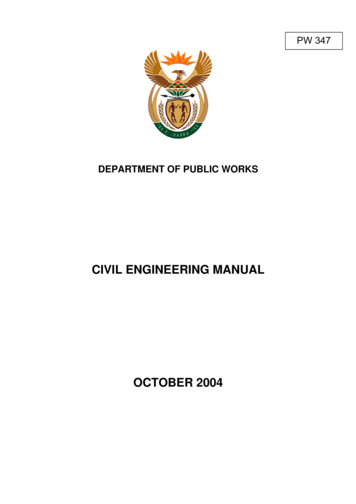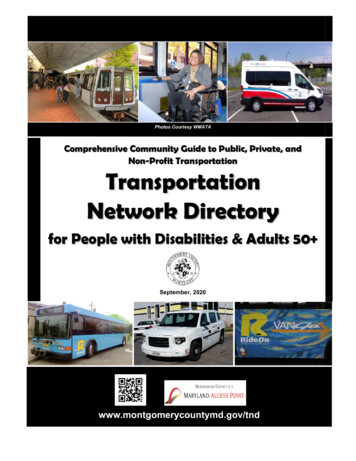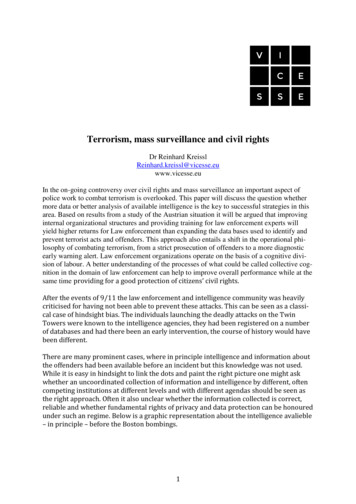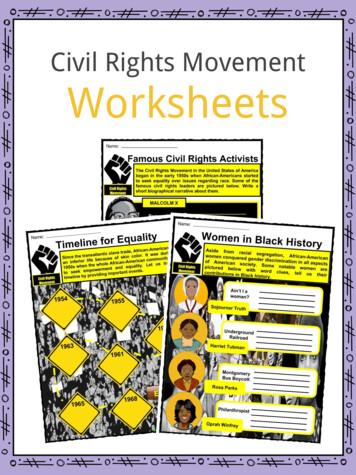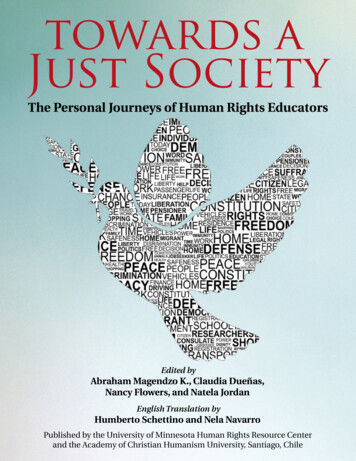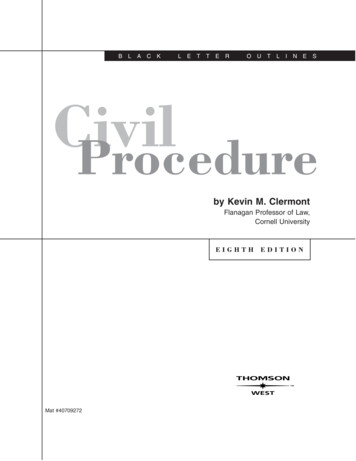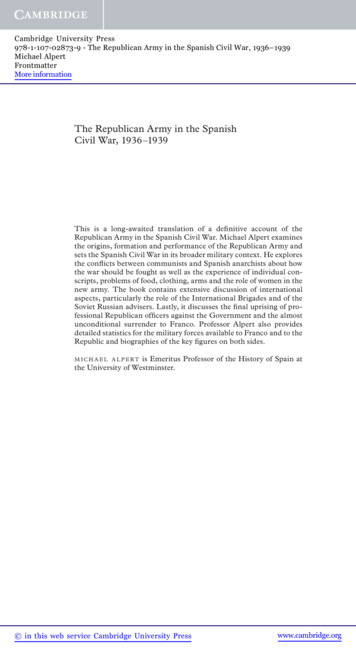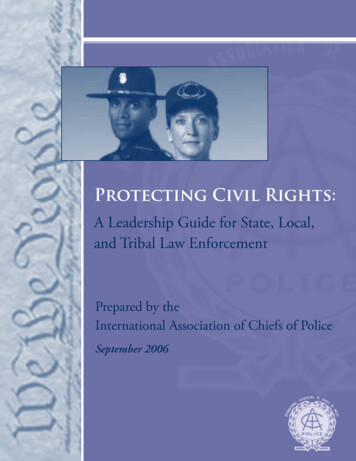
Transcription
Protecting Civil Rights:A Leadership Guide for State, Local,and Tribal Law EnforcementPrepared by theInternational Association of Chiefs of PoliceSeptember 2006
Protecting Civil Rights:A Leadership Guide for State, Local,and Tribal Law EnforcementThis project was supported by Grant Number 2003-HS-WX-K309 awarded by the U.S.Department of Justice Office of Community Oriented Policing Services (the COPSOffice). Views expressed in this document are those of the International Associationof Chiefs of Police and do not necessarily represent the official position or policiesof the COPS Office or the U.S. Department of Justice.
September 2006Dear Colleague:The International Association of Chiefs of Police (IACP) is pleased to present the new publication,Protecting Civil Rights: A Leadership Guide for State, Local, and Tribal Law Enforcement. Fundedby the Office of Community Oriented Policing Services, the guide examines the experiencesof a wide cross section of agencies proactively engaged in protecting civil rights as well asthose that have come under federally mandated monitoring resulting from investigations ofpatterns or practices of civil rights violations. The guide references the exemplary policies andpractices of departments promoting civil rights as well as the content of the consent decreesand memorandums of agreement that individual police agencies have signed with the U.S.Department of Justice. The guide relies on information obtained from focus groups, as well as keyadvisors in the law enforcement community and the IACP standing committees on civil rights andprofessional standards. Finally, the guide is informed by the activities and staff of two distinct, yetcomplementary, agencies within the U.S. Department of Justice: the Special Litigation Section ofthe Civil Rights Division and the Community Relations Service.By bringing these sources together, the guide provides a comprehensive overview ofthe civil rights issues and challenges that today’s law enforcement leaders face. It offerspractical recommendations for addressing these challenges, but more important, it includesrecommendations that encourage leaders to engage in full community partnerships in ways thatboth protect and promote civil rights.In short, this effort expresses the conviction that law enforcement leaders can and must learn asmuch as possible from the perspectives and direct experiences of their professional peers. Throughsuch exchanges, chief executives can gain insights into the best ways to serve their communitiesusing promising strategies and practices that are respectful, ethical, and effective. We hope that alllaw enforcement leaders will recognize the need for visionary leadership in these areas and willlook to this guide as a valuable tool in their ongoing efforts to protect and promote civil rights.Sincerely,Chief Mary Ann ViverettePresident, IACPGaithersburg (Maryland) Police DepartmentChief John FinneganBarnstable (Massachusetts) Police DepartmentChair, IACP Civil Rights CommitteeChief Charles A. GruberSouth Barrington (Illinois) Police DepartmentChair, IACP Professional Standards Committee
Acknowledgments
AcknowledgmentsAcknowledgmentsMany individuals representing different organizations and professional vantage points onthe issue of civil rights in law enforcement made this publication possible. The scope of theirdirect contributions, advice, counsel, and editorial comments extends well beyond what canbe acknowledged here. Contributors and advisors are discussed below under groupingsbased on their primary affiliation. This format is a matter of convenience and organization;it should in no way detract from the collaborative nature of this endeavor. Indeed, atremendous amount of overlap and cross-fertilization occurred among these groups as thisproject unfolded.International Association of Chiefs of Police: Standing CommitteesTwo standing committees of the International Association of Chiefs of Police (IACP), theCivil Rights and Professional Standards, played pivotal roles in this project from inceptionto completion. Members of these committees are listed in Appendix A and Appendix B,respectively, of this guide. Individual members contributed their unique insights andperspectives. Several are singled out below.Fittingly, we start with expressing deep appreciation to Barbara “Bobi” Wallace, whoseprofessional commitment to civil rights and personal drive served as an inspiration for thisproject. Chief Wallace’s enthusiasm was contagious. As the chairperson, she was the drivingforce behind the Civil Rights Committee and its collective embrace of this project. Ms.Wallace was chief of the Community Relations Unit of the FBI at the onset of the project.Although Bobi has since retired from the FBI and stepped down from the committee’s chair,her enthusiasm and vision remained driving forces in this effort.Charles A. Gruber, chief of the South Barrington (Illinois) Police Department and currentchair of IACP’s Professional Standards Committee, played a role parallel and complementaryto Ms. Wallace. Throughout the course of the project his steadfast guidance, insights, andsupport were vital. The Leadership Guide has benefited immensely from his long-standingprofessional commitment to civil rights, his role in initiating IACP’s Civil Rights Committee in1990, and his leadership.John Finnegan, chief of the Barnstable (Massachusetts) Police Department, assumed the chairof the Civil Rights Committee when Ms. Wallace retired. Chief Finnegan’s resolute supportand direction helped sharpen the practical focus of the guide and helped to integrate it withthe broader work of the Civil Rights Committee. Chief Finnegan was instrumental providingfeedback as well as in soliciting valuable input and insights from committee members.As a whole, the Civil Rights and Professional Standards Committees provided support andguidance. Individual members took on various chapters for review and a debt of gratitudeis extended to all. A special debt of gratitude is extended to Leonard Cooke, director of theVirginia Department of Criminal Justice Services, for the detailed review that he and his
Acknowledgmentsstaff provided across all chapters. Chief Richard Rappoport, Fairfax City (Virginia) PoliceDepartment, provided extensive comments and edits on the topic of racial profiling (Chapter5), a particularly complex and challenging chapter. In the same vein, Chief Charles Reynolds,retired from the Dover (New Hampshire) Police Department, provided keen insights anddirection on use-of-force issues (Chapter 4). Chief Susan Riseling, University of Wisconsin—Madison Police Department, contributed perceptive commentary that helped to improve thetone and language of the guide. Chief Patrick Oliver, retired from the Fairborn (Ohio) PoliceDepartment, imparted thoughtful insights and edits, particularly on the content related toethics and community outreach. Chief James Hussey, from the Cohasset (Massachusetts)Police Department, provided commentary and suggestions about the role of personnelmanagement as a means of promoting civil rights.Project Advisory GroupIn April 2004, project staff convened an advisory group in Memphis to discuss the projectand the direction it should take. Besides representatives serving on IACP’s Civil Rights andProfessional Standards Committees, project staff brought together others specializing incivil rights accountability and oversight. Under the umbrella of an advisory group, manyindividuals representing different perspectives—including academia and persons experiencedas monitors for federal consent decree and memorandums of understanding—helped providedirection in the project’s early stages. Advisory group members also provided review anddirection on substantive content as an annotated outline for the guide was developed andrevised. Members of the Project Advisory Group are listed in Appendix C.Project Focus GroupIn April 2005, the IACP convened a group of law enforcement executives from across thenation in Pittsburgh to provide feedback and to help hone a draft of recommendations for lawenforcement policies and practices to promote civil rights. This Project Focus Group includedrepresentatives from agencies that had successfully navigated federal oversight or were inthe process of doing so.The Pittsburgh Bureau of Police played a key role in helping organize this meeting andprovided a wealth of information relevant to its reforms and the successful conclusion ofoversight under a federal consent decree. We are particularly indebted to Chief RobertMcNeilly (now retired), Deputy Chief Earl Woodyard, and Commander William Valenta(retired), for their assistance, consultation, and their overall contributions to the field,particularly with respect to early intervention strategies. The full list of participants in ProjectFocus Group is in Appendix D.ii
AcknowledgmentsU.S. Department of JusticeFrom within the Department of Justice the project relied on the expertise and assistance fromthree separate offices.First, we are indebted to the Special Litigation Section (SPL) within Civil Rights Division. Asthe section responsible for conducting pattern or practice investigations, brokering consentdecrees and memorandums of agreement, and overseeing reforms, the SPL played a pivotaland patient role in helping IACP staff understand the complexities and nuances of theprocess. We are particularly indebted to the direct roles that Shanetta Y. Cutlar, chief of theSPL, and Tammie Gregg, deputy chief, played as advisors and facilitators in this endeavor.Staff from throughout the SPL provided comments on early outlines of the guide and wereinstrumental in helping ensure that the document was comprehensive and well balanced.Second, we are also indebted to the Community Relations Service (CRS) within theDepartment of Justice. Director Sharee Freeman was a loyal advisor throughout the courseof this project. George Henderson, general counsel for CRS, and Timothy Johnson, seniorconciliation specialist, were instrumental in helping project staff understand the role of CRSin promoting civil rights and distinguishing CRS’ role addressing civil rights concerns fromthat of the Civil Rights Division. Mr. Henderson was also instrumental in convening a groupof CRS staff to help underscore and illustrate the scope and variety of assistance.The third component within the Department of Justice to whom we owe our deepestgratitude is the Office of Community Oriented Policing Services (COPS). We thank the COPSOffice not just for funding the project, but also for providing consistent and active support aswell as direct contributions. Director Carl Peed was instrumental in helping initiate the project.His participation in and support for the project was invaluable and helped to underscore theimportant role that community policing, and the COPS Office in particular, have played inpromoting policing that is more fair, more responsive to the community, and more effective.Deputy Director Pam Cammarata served as the COPS project manager. Her support, insights,and direct involvement helped to bring us together with other COPS grantees involved insimilar work. These contacts and our participation in various workshops and symposiasponsored by COPS were indispensable in helping define the scope of the project andensuring that our approach was balanced and complementary to the efforts other COPSgrantees working on projects focused on civil rights. A final debt of gratitude is extended totwo contract employees of COPS: Judith Beres for her editing of this document and AyonnaJohnson for her work on the layout of this document.iii
AcknowledgmentsIACP Leadership and Project PersonnelMany IACP personnel provided guidance, support, and input into this project. Leadership andproject staff that had an impact on this work include the following.Executive StaffChief Mary Ann ViverettePresidentEugene CromartieDeputy Executive DirectorDan RosenblattExecutive DirectorJohn FirmanIACP Research Center DirectorProject StaffJohn MarkovicProject Director and Principal AuthorMajor Keven GrayMaryland State PoliceIACP FellowChristine AllredContent Editor and Writing ConsultantLieutenant Sharon MalloyU.S. Capitol PoliceIACP FellowColin MayProject Assistant and Contributing AuthorSergeant Steven BrochuCharlotte-Mecklenburg (North Carolina)Police DepartmentIACP Visiting FellowDarron MasonIACP InternLieutenant Ed DadishoSuisun City (California) Police Department(Formerly with Los Angeles Police Department)IACP Visiting FellowivSerena WernerIACP Intern
Executive Summary
Executive SummaryExecutive SummaryPROTECTING CIVIL RIGHTS:A Leadership Guide for State, Local, and Tribal Law EnforcementBACKGROUNDProtecting Civil Rights: A Leadership ImperativeAll law enforcement leaders recognize the ethical and legal imperatives to which they andtheir officers must adhere to ensure that civil rights of all individuals in their communities areprotected. Law enforcement officers, in fact, are the most visible and largest contingent ofthe nation’s guardians of civil rights. Every police officer commits to upholding the nation’sprime guarantor of rights, the U.S. Constitution, when sworn into office. To be effective,a police department and its individual officers must be seen primarily as protectors ofcivil rights, rather than agents of social control whose main purpose is to limit individualfreedoms. The effectiveness of police in their varied missions—from law enforcement tocommunity service—depends on the trust and confidence of the community. Public trust andconfidence are severely reduced when individuals’ civil rights are compromised. And whenany community perceives that its civil rights are systematically violated by the police, allsense of trust, cooperation, and partnership between the police and that community will beundermined.Understanding these ethical imperatives, law enforcement leaders must be continuallyvigilant to ensure that the actions of their officers do not violate civil rights and do notcompromise public support. Officers are granted a tremendous amount of authority anddiscretion to enforce the law, that is, to protect individual rights from being infringed upon byothers in the community. At the same time, officers themselves must act within the confinesof the Constitution while executing their tremendous power and wide discretion. They mustnever consider themselves above the law while executing their responsibility to enforcethe law. This commitment is what distinguishes police in constitutionally based, democraticsocieties like ours from police in nondemocratic countries, where they too often are perceivedas oppressive agents of a government whose main purpose is to restrict, rather than protect,the rights of civilians.Across the United States, law enforcement personnel have an overwhelmingly positiverecord of accomplishment for respecting and protecting civil rights. Leaders should find itheartening and a source of pride that the vast majority of the countless interactions thatofficers have with civilians result in actions that are conducted lawfully, professionally, andwithin constitutional boundaries. The fact that the overwhelming majority of police officersroutinely respect civil rights under the most trying and volatile conditions is remarkable.Given the risks inherent in police work and the grave consequences that can occur when civilrights are violated, law enforcement leaders must be unwavering in holding their officersaccountable. Their officers are vested with authority and discretion that can be abused. Unlikevii
Executive Summaryany other profession, the possibility of violating civil rights, or being perceived as violatingcivil rights, is inherent in many of the duties officers are required to perform on a day-to-daybasis. Unfortunately, the notoriety and harm that arise from even isolated instances of civilrights violations can easily overshadow the vast majority of police-civilian encounters that areperformed respectfully and professionally.Law enforcement leaders bear the tremendous responsibility to ensure that individual officersand units within their agencies uphold the law and its most basic guarantees. Realistically,law enforcement leaders recognize that on rare occasions officers will violate a civilian’s civilrights, wittingly or unwittingly. On even rarer occasions, groups of officers or small factionswithin an agency may act without regard for civil rights, perhaps even asserting that effectivelaw enforcement can come only at the expense of civil rights. Leaders must be resolute intheir responses to isolated incidents of civil rights violations to minimize damage and set aclear example. In the case of officers who systematically violate civil rights, their behaviormust not be tolerated and action must be decisive and uncompromising. Effective leaders,supported by the managers who serve them, must strive to identify and intervene whenofficers exhibit potentially problematic behavior before it escalates to the point of violatingcivil rights.Against this backdrop, the seriousness of law enforcement leaders’ responsibility tocommunicate a consistent and far-reaching commitment to civil rights protections cannot beoverstated. Although laws, departmental policy directives, and standard operating proceduresare critically important, law enforcement executives’ leadership and communication skills arethe most critical elements for ensuring that officers regularly exercise sound judgment andengage in professional and ethical policing.Law enforcement leaders can and must demonstrate a fundamental and complete allegianceto civil rights protections in a coordinated manner using multiple approaches. They mustclearly convey a simultaneous commitment to effective law enforcement and civil rightsprotection; they must codify this commitment in their agency’s mission statements; theymust ensure that their department’s polices are clear, sound, and consistent with civil rightsguarantees; they must train and supervise officers in manners that are consistent with thiscommitment; and they must respond to alleged civil rights violations with vigilance and withfair and decisive action. As law enforcement leaders succeed in these regards and make theseefforts transparent to the public, they validate the core premise that civil rights protectionis not only an ethical and legal imperative but a practical imperative as well. Protectingcivil rights is good for police, good for the community, and essential for maintaining thepartnerships that must exist between the two.Federal Investigations: A Response to “Patterns or Practices” of Civil Rights ViolationsDespite the ethical, legal, and practical imperatives to protect civil rights, law enforcementofficers occasionally abrogate their oaths. When these unwitting or intentional violationsof citizens’ civil rights go unaddressed, they can escalate into more widespread patternsor practices of civil rights violations that can undermine the credibility of an entire lawviii
Executive Summaryenforcement agency and erode public trust and confidence. Moving beyond isolatedinstances, pattern or practice violations of civil rights comprise an urgent call to lawenforcement executives and the municipal, county, or state governments under which theyserve to reassume the ultimate responsibility for ensuring that officers uphold their oaths ofoffice and adherence to constitutional guarantees.During the last decade, the federal government has responded to such situations in the rare,but urgent circumstances where allegations of pattern or practice civil rights violations havearisen. The passage of the Violent Crime Control and Law Enforcement Act of 1994 (PublicLaw No: 103-322) enabled the federal government to take action to remedy any pattern orpractice of conduct by state and local law enforcement agencies “that deprives personsof rights, privileges, or immunities secured or protected by the Constitution or laws of theUnited States.” In response to this enabling legislation, the Special Litigation Section ofthe Civil Rights Division of the U.S. Department of Justice assumed the responsibility forinvestigating alleged pattern or practice civil rights violations and for establishing remedies tosuch violations.During the last decade, the Special Litigation Section has investigated an array of allegedpattern or practice civil rights violations including the following: Unlawful or excessive use of forceInadequate training on use-of-force techniquesRacial profilingIllegal stops and searchesIntimidation by policeHarassment of civilians in retaliation for reported misconductInadequate supervisionFailure to investigate alleged officer misconduct.Investigations by the Special Litigation Section resulting in a determination of actionable civilrights violations generally have been resolved through negotiated agreements in the formof memorandums of agreement (MOA) or consent decrees. Through such agreements, thefederal government and law enforcement agencies agree to a course of action to correct thepatterns of civil rights violations and to remedy the conditions that allowed the violations tooccur. Since 1994, 14 agencies have been or currently are under federal monitoring as a resultof civil rights violation investigations. While these 14 agencies represent an infinitesimalfraction of the country’s nearly 18,000 state, county, local, tribal, and special jurisdictional lawenforcement agencies, the impact of these federal investigations and agreements has beenand continues to be profound and far-reaching.ix
Executive SummaryASSERTING A LEADERSHIP ROLEThe very existence of these investigations reminds us of the critical messages andmanagement strategies that law enforcement leaders must assert—or reassert—in theirefforts to protect and promote civil rights. Accordingly, the International Association ofChiefs of Police’s (IACP) release of Protecting Civil Rights: A Leadership Guide for State, Local,and Tribal Law Enforcement is meant to serve as a compass for law enforcement leaderscommitted to affirmatively addressing civil rights issues. The guide originated in a series ofdiscussions among representatives from U.S. Department of Justice—specifically the Officeof Community Oriented Policing Services and the Special Litigation Section of the Civil RightsDivision—and the IACP. It realizes their shared conviction that the accumulated knowledgeof law enforcement leaders who have undergone a federal civil rights investigation andresultant monitoring, coupled with that of law enforcement leaders who have proactivelydemonstrated exemplary records of protecting and promoting civil rights, can and shouldbenefit all other law enforcement leaders. To make this accumulated knowledge available tolaw enforcement leaders, the IACP took several discrete steps.First, the IACP engaged in a comprehensive review of federal pattern and practiceinvestigatory processes. This review revealed that these processes are constantly evolving.For instance, the Special Litigation Section has increasingly relied on expert consultants withdirect law enforcement experience for providing technical assistance to departments underinvestigation. The investigations themselves have become increasingly transparent to thedepartments. The IACP’s review also revealed that these processes are highly individualized.They are shaped by the nature of the allegations, by the findings specific to each jurisdiction,and by the tone and comprehensiveness of an agency’s response. While these investigationsoften are viewed as adversarial, new leaders with reform agendas and who were intenton resolving inherited civil rights problems, often made the best of these situations. Theseleaders were committed to responding positively to the direction and assistance that federalintervention could offer and worked with the Special Litigation Section and its consultantsto establish cooperative investigatory processes. In fact, several chief executives wereinstrumental in requesting that the investigations take place. Leadership responses such asthese have enabled the Special Litigation Section to work effectively with these agencies andto build on the agencies’ preexisting successes.Second, the IACP engaged in a comprehensive review of the MOAs and consent decreesresulting from these federal investigations. These agreements are of broad value becausethey condense the insights of formal and extensive inquiries about civil rights violationsinto clear and practical mandates for new courses of action. These agreements articulatespecific remedies for patterns of civil rights violations including the excessive use of force,racial profiling, and other forms of police misconduct. They also address accountability ormanagement practices, such as early intervention systems and critical incident reviews, thatcan help address and prevent civil rights violations as well as limit department liability. Theseagreements provide valuable insight for chief executives who are determined that effectivelaw enforcement and the protection of civil rights will be missions that are complementary totheir agencies.
Executive SummaryThird, the IACP explored other agencies’ internal solutions to protecting and promotingcivil rights. During the same decade that 14 agencies underwent federal investigation andresultant monitoring for pattern or practice civil rights violations, other agencies addressedchallenging civil rights concerns on their own initiatives. In developing the guide, the IACPrecognized that these agencies would be an equally important, if not more important,source of insight. Law enforcement leaders in these agencies worked to protect communitymembers’ civil rights by proactively enacting sound policies, comprehensive training, farreaching and close methods of supervision, and more effective systems of accountability.Finally, the IACP gathered all of this information into this concise, yet comprehensive guide.In its first chapter, Protecting Civil Rights: A Leadership Guide for State, Local, and TribalLaw Enforcement Leaders familiarizes law enforcement leaders with federal pattern orpractice investigatory processes as well as general resources and strategies available to alldepartments committed to protecting and promoting civil rights. In the remaining chapters,the guide offers in-depth discussions of the policies, procedures, and practices that are criticalto civil rights protection.For the benefit of law enforcement leaders, the guide crystallizes these in-depth discussionsinto concise recommendations. In summary, Protecting Civil Rights is designed to enable lawenforcement leaders to learn from their peers who have engaged in deliberate strategies,both with and without federal intervention, to protect civil rights.SELECTED RECOMMENDATIONSProtecting Civil Rights recognizes that the motivation to safeguard civil rights must emergeout of law enforcement executives’ visionary leadership, but then must be continuallyreinforced by internal, and in some instances external, accountability mechanisms.Accordingly, the guide offers recommendations in six substantive areas including earlyintervention, the civilian complaint process, use of force, racial profiling, personnelmanagement, and data management. The following is a sampling of key recommendations.Early Intervention Strategies All agencies, regardless of size, should strive to incorporate the core concepts of earlyintervention into their personnel management practices. Early intervention strategies,when properly designed and implemented, allow supervisors to address concerns aboutofficers’ behavioral patterns before they escalate to a point where discipline would beneeded. Many large agencies have now developed sophisticated early interventionsystems that rely on computerized data-driven approaches that automatically alertsupervisors to potential problems. Any size department, large, medium, or small,however, can use early intervention strategies in its day-to-day supervisory practiceswithout needing to rely on sophisticated technology solutions.xi
Executive Summary Agencies seeking to develop early intervention should look to their peers for ideas, butmust recognize that they will have to tailor their own system to their department’sneeds. Every department’s supervisory and information management practices areunique. Because these practices are at the core of early intervention strategies, there is noone-size-fits-all strategy. Nonetheless, agencies should look to their peers for practical andtechnological advice on how to plan for and build these systems and then carefully tailorthe best features of these external systems to meet their own department’s structure, data,and needs. Agencies should strive to include as many stakeholders as possible in the planning ofearly intervention systems. Many individuals, groups, and associations have a stake inearly intervention strategies. When designing these strategies, agencies should seek inputfrom a wide cross section of internal representatives including rank-and-file officers,supervisors, personnel managers, and data management/information technology staff.Many departments have also found it useful to seek external input by involving the policeunion and the community in the planning process. Agencies should ensure that supervisors have the appropriate experiences, skills, andtraining to perform their early intervention responsibilities. An early intervention datamanagement system is not a panacea for resolving personnel problems and officermisconduct issues. The system will only work as well as those who use it. First-linesupervisors must be trained specifically in the use of the system and in making soundearly intervention judgments for the system to be an optimal management tool that willresult in genuine and effecti
A Leadership Guide for State, Local, and Tribal Law Enforcement BACKGROUND Protecting Civil Rights: A Leadership Imperative All law enforcement leaders recognize the ethical and legal imperatives to which they and their officers must adhere to ensure that civil rights of all individuals in their communities are protected.

